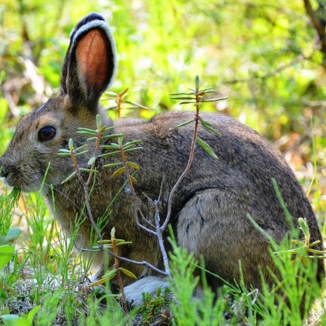|
Rabbits and hares are small mammals with long front teeth, fluffy short tails, and long hind legs they use for hopping and jumping. Hares are often called rabbits, and both are members of the family Leporidae. However, hares are born fully furred and with eyes open, while newborn rabbits are blind and hairless. There are two species of hares in Alaska, both of which turn white in the winter. Hares are most active at dusk and dawn. They do not dig burrows or build nests but use natural shelters and depressions and rest under branches or bushes. The snowshoe hare travels about on well-established trails or runways which become deeply worn in the snow or forest floor. It is interesting that the winter trails through the deep snow follow the summer pathways.
The snowshoe hare is the most common and widespread hare in Alaska, found everywhere in the state except the lower Kuskokwim Delta, the Alaska Peninsula, and the area north of the Brooks Range. They generally live in brush, mixed spruce forests, and wooded swamps. Snowshoe hare populations are dramatically cyclical, and in peak years there may be up to 600 snowshoe hares per square mi (230/km²) of the animals' range. The hares are a key food source for Alaska's furbearers, especially lynx, and are also important for human subsistence and recreational hunting.
Snowshoe hares are somewhat larger than cottontail rabbits..They average around 18 to 20 inches in total length and weigh 3 to 4 pounds.. In summer the coat is yellowish to grayish brown with white underparts, and the tail is brown on top. This coat is shed and replaced by white pelage in winter, but the hairs are dusky at the base and the underfur is gray. The ears are dark at the tips. The large hind feet are well-furred, adapting these animals for the deep snows of the boreal forest, hence the name “snowshoe.”
Snowshoe hares are found in mixed spruce forests, wooded swamps, and brushy areas. Snowshoe hares eat a variety of plant materials. Forage type varies with season. Succulent green vegetation is consumed when available from spring to fall; after the first frost buds, twigs, evergreen needles, and bark form the bulk of snowshoe hare diets until spring..
The gestation period is 35 to 40 days; most studies report 37 days as the average length of gestation. Litters average three to five leverets depending on latitude, elevation, and phase of population cycle, ranging from one to seven. Female snowshoe hares can become pregnant anytime after the 35th day of gestation. The second litter can therefore be conceived before the first litter is born (snowshoe hares have twin uteri). Pregnancy rates ranged from 78 to 100% for females during the period of first litter production, 82 to 100% for second litters, and for the periods of third and fourth litters pregnancy rates vary with population cycle. Females normally first breed as 1-year-olds. Juvenile breeding is rare and has only been observed in females from the first litter of the year and only in years immediately following a low point in the population cycle.
The tundra hare, or Alaska hare as it is also called, is most often found on the western coast of Alaska, including the Alaska Peninsula, and can occasionally be seen on the Arctic coast and the north slope of the Brooks Range. It generally lives on rocky slopes and upland tundra, avoiding lowlands and forests.
The Alaskan hare one of the largest hares and is larger than the snowshoe hare measuring 22 to 28 inches in length and weighing 6 to 12 pounds. The winter coat of this large hare is long and the fur is white to the base. Edges of the ears are blackish. In summer the coat is grayish brown above and white below, with a whitish base to the hairs. The tail is entirely white. Alaskan hares have robust skulls, strongly recurved upper incisors, and stout claws for digging in the snow. Unlike most hares, they have fairly short ears to conserve heat in the arctic environment.
The Alaskan hare is generally found on windswept, rocky slopes and upland tundra, often in groups. These big hares usually avoid lowlands and wooded areas. They feed on willow shoots and various dwarf arctic plants.
Female Alaskan Hares nurse their young for an extended period, providing them with enough nutrition to grow extraordinarily quickly during the short Alaskan summer. There are an average of six furry little hares in a litter, and females usually bear just one litter per year.
|







